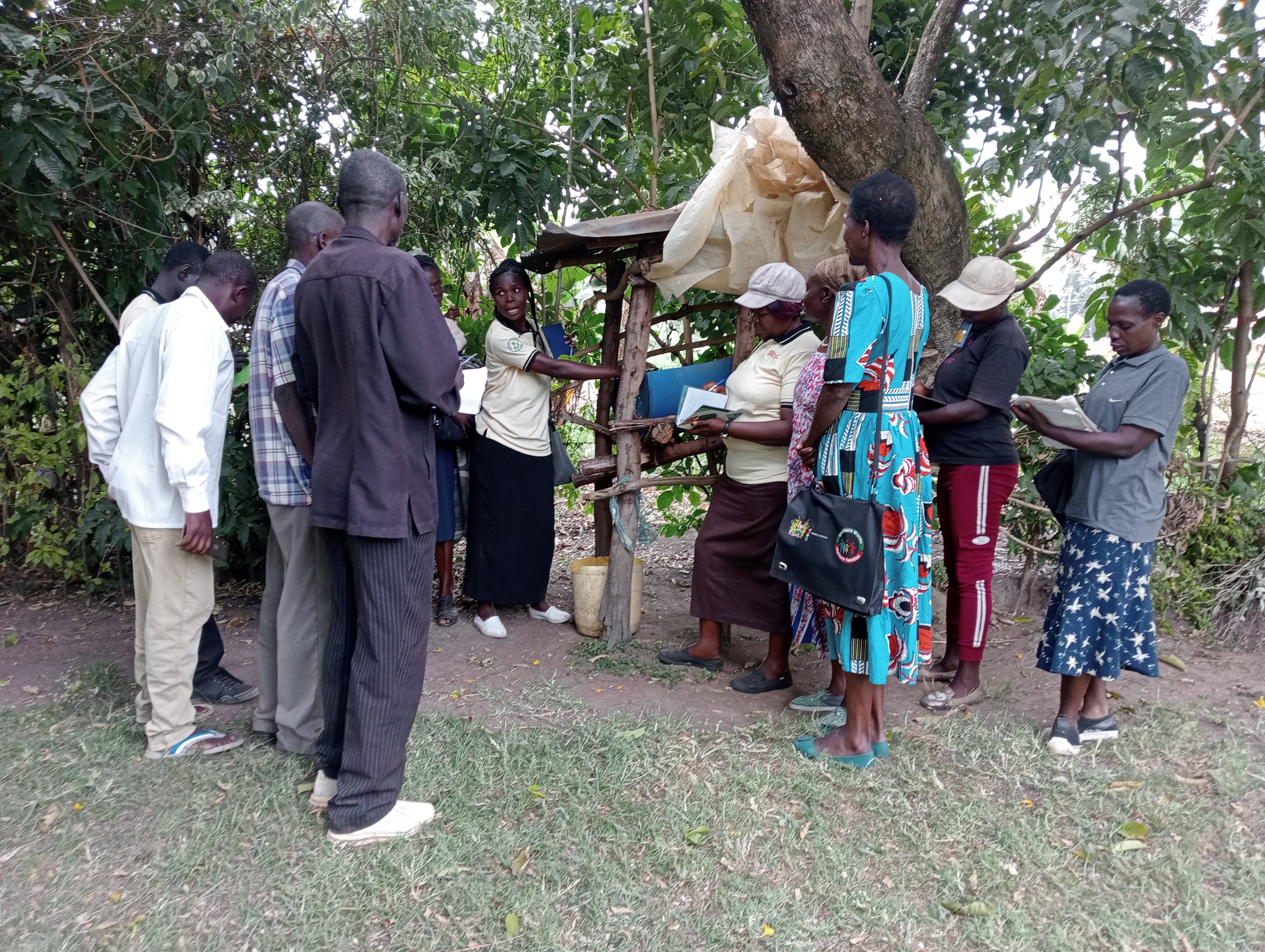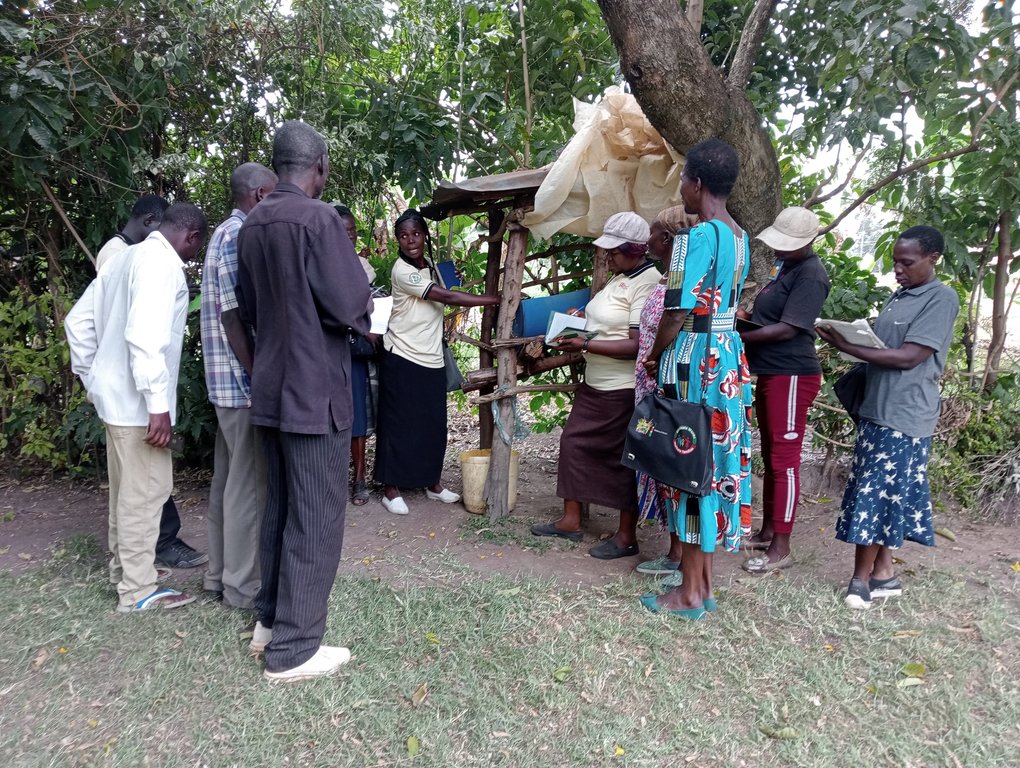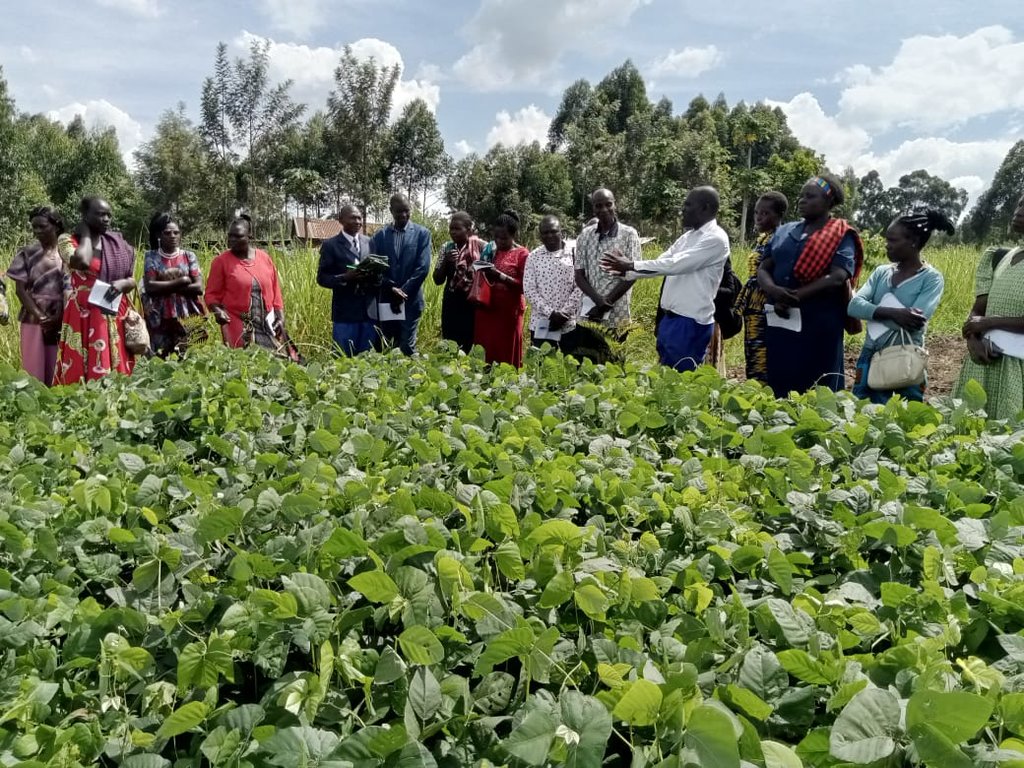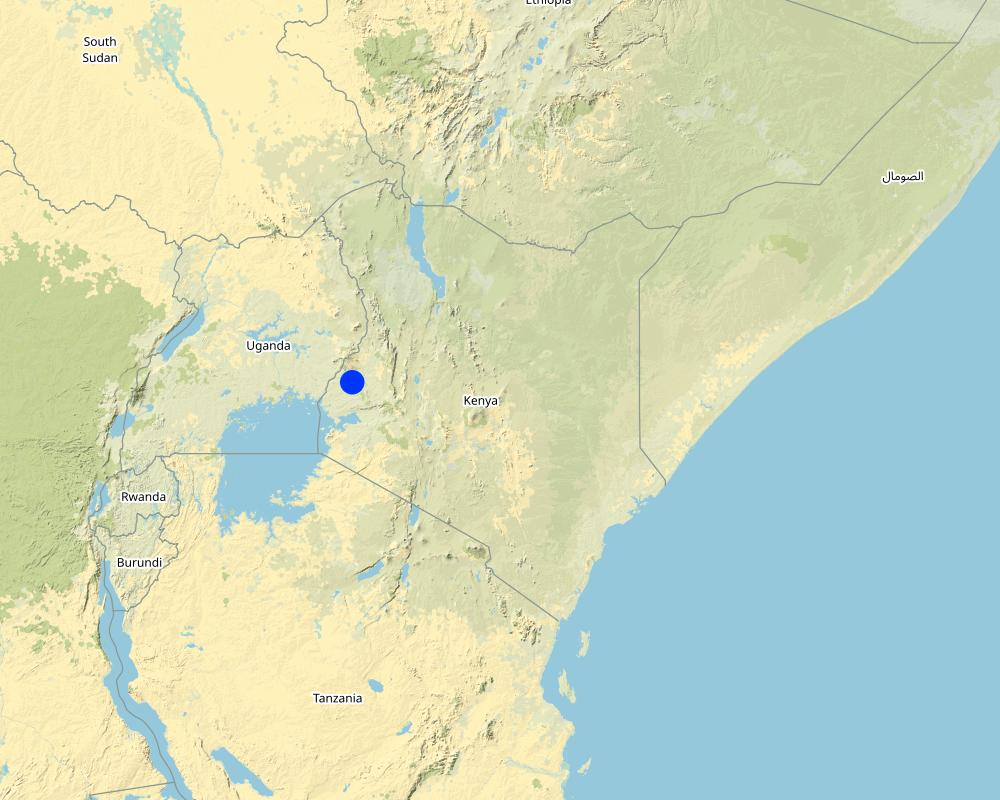Community Resource Persons (CRP) in agricultural extension [肯尼亚]
- 创建:
- 更新:
- 编制者: William Akwanyi
- 编辑者: Maureen Elegwa, Innocent Faith, Noel Templer
- 审查者: William Critchley, Rima Mekdaschi Studer
Mtu wa rasilimali za jamii/ Mkufunzi wa wakufunzi
approaches_6688 - 肯尼亚
查看章节
全部展开 全部收起1. 一般信息
1.2 参与方法评估和文件编制的资源人员和机构的联系方式
关键资源人员
SLM专业人员:
Nyanja Churchill
+254 710 849370
churchillwn2@gmail.com
Kimaeti Farmers Community-Based Organization (CBO)
Bukembe East Ward, Kanduyi Sub-county, Bungoma County
肯尼亚
SLM专业人员:
SLM专业人员:
有助于对方法进行记录/评估的项目名称(如相关)
Soil protection and rehabilitation for food security (ProSo(i)l)有助于对方法进行记录/评估的机构名称(如相关)
Deutsche Gesellschaft für Internationale Zusammenarbeit (GIZ)有助于对方法进行记录/评估的机构名称(如相关)
Alliance Bioversity and International Center for Tropical Agriculture (Alliance Bioversity-CIAT) - 肯尼亚1.3 关于使用通过WOCAT记录的数据的条件
(现场)数据是什么时候汇编的?:
03/02/2023
编制者和关键资源人员接受有关使用通过WOCAT记录数据的条件。:
是
1.4 SLM技术问卷的参考
2. SLM方法的描述
2.1 该方法的简要说明
Community Resource Persons (CRP) form a farmer-to-farmer learning approach that bridges the gap in agricultural extension, increases farmers' access to agricultural information (SLM knowledge), and increases the adoption of SLM practices.
2.2 该方法的详细说明
该方法的详细说明:
Community Resource Persons (CRPs) are farmers at the community-level who promote the adoption of SLM technologies by offering agricultural extension services. GIZ implements the ProSoil project in the Western Kenya counties of Kakamega, Siaya, and Bungoma through partners i.e., Welthungerhilfe (WHH) and Gesellschaft für Agrarprojekte in Übersee (GFA Consulting Group/ GFA). Further, these partners collaborate with other local non-governmental organizations (NGOs) and community-based organizations (CBOs) in the implementation of the project. Farmer groups belonging to local communities characterized by men, women, and youth are recruited by field officers from the implementing partners and trained in Sustainable Land Management (SLM) practices. The training is done by technical staff from the County Department of Agriculture. The implementing partners facilitate the trainings. The trained farmers (CRPs) are issued with certificates of recognition signed by GIZ ProSoil project manager, the head of the implementing partner, and the County Director of Agriculture at the County Department of Agriculture. These CBOs and farmer groups work closely with agricultural extension officers from the county departments of agriculture to disseminate different agricultural technologies and SLM measures. The aim of CRPs is to bridge the gap in agricultural extension by overcoming the problem of low extension staff-to-farmer ratios. The objective is to sustain the adoption of various SLM measures promoted by the project among the beneficiaries and non-project farmers.
In Bukembe East Ward, Bungoma County, GFA collaborates with Kimaeti Farmers CBO to implement the Soil Protection and Rehabilitation of Degraded Soil for Food Security (ProSoil) project. Kimaeti Farmers CBO recruited agriculture field technicians who were then trained in SLM practices by GFA. The trained field technicians sensitize local communities in various operational areas about the project and recruit farmer groups: 25 farmers per group. Each field technician manages several groups per sub location and takes them through trainings and demonstrations on soil protection and rehabilitation technologies. Farmer groups are also trained on group organization development and management to enhance group cohesion. Each farmers group selects 3 CRPs who undergo specialized training to equip them with more skills and expertise to follow up, mentor and coach fellow farmers. These CRPs also monitor implementation of various technologies, gather farmer feedback, and even reach out to other farmers in the community not reached by the project. This extension service is usually done voluntarily. However, some farmers reward the CRPs for the advisory services in cash or kind. In some cases, CRPs who are specialised in some SLM technologies e.g., construction of structures for vermicomposting become co-trainers and may enter into contractual agreements with GIZ, GFA, or any other institution that wants their services. In this case, they are paid as agreed on the contracts.
Each CRP manages a cluster of 5–7 farmers. They also reach out to farmers within their respective communities according to consultatively agreed calendars/timeframes. Every available opportunity is used by CRPs to spread SLM knowledge, including meeting farmers at their farms; convening farmers at common locations within their communities where they talk to them about SLM; farmer field days organised by the implementing partners, or the county department of agriculture, etc. Hence, CRPs attract the attention of many farmers, including those who are direct beneficiaries of the ProSoil project and those who are not direct beneficiaries. CRPs are thus important in improving farmers' access to agricultural information at little or no cost since CRPs work on a voluntary basis.
The CRP approach has been successful in bringing together female and male, and youthful, middle-aged, and elderly farmers of different socio-cultural and economic backgrounds on issues of common interest i.e., SLM, household food security, and economic empowerment. This has enhanced communication, built social solidarity, and enhanced social cohesion among the farmers.
2.3 该方法的照片
2.5 采用该方法的国家/地区/地点
国家:
肯尼亚
区域/州/省:
Bungoma County in Western Kenya
有关地点的进一步说明:
Bukembe East Ward, Kanduyi Sub-county, Bungoma County
Map
×2.6 该方法的开始和终止日期
注明开始年份:
2021
注释:
Farmers are still learning from each other through the CRP approach.
2.7 方法的类型
- 基于项目/方案
2.8 该方法的主要目的/目标
Aim: To bridge the gap in agricultural extension.
Objectives:
1. To improve farmers' access to agricultural information.
2. To sustain the adoption of new technologies trained to the project beneficiaries and non-project farmers.
3. To overcome the problem of low extension staff-to-farmer ratio through farmer-to-farmer learning.
2.9 推动或妨碍实施本办法所适用的技术的条件
社会/文化/宗教规范和价值观
- 启动
1. General acceptance by the community.
2. Ability to bring together of different socio-cultural and economic backgrounds on issues of common interest i.e., SLM, household food security, and economic empowerment which has enhanced communication, built social solidarity, and enhanced social cohesion among community members.
财务资源和服务的可用性/可得性
- 阻碍
CRPs work on voluntary basis; hence, may not be motivated to reach out to farmers in areas that are very far from their reach.
机构设置
- 启动
Availability and willingness of Kimaeti CBO to collaborate with GFA.
参与者的的协作/协调
- 启动
Linkages and partnerships among different organizations and institutions, including GIZ, GFA, Kimaeti CBO, etc. which expanded the outreach of the approach.
法律框架(土地使用权、土地和水使用权)
- 启动
Access to farming land where farmers implement SLM technologies.
土地治理(决策、实施和执行)
- 阻碍
Women and youth farmers are limited in their access, use, and control of land. Hence, they may not be able to implement certain SLM technologies even if they gained knowledge about them through CRPs who are fellow farmers e.g., agroforestry.
了解SLM,获得技术支持
- 启动
SLM knowledge among technical staff in the collaborating institutions and documented references.
工作量、人力资源可用性
- 启动
CRPs from the communities who are willing to work with fellow farmers.
- 阻碍
Voluntary nature of the CRPs' support - CRPs are likely to sacrifice their own farmwork at the expense of the CRP work, something that may discourage them if they get poor harvest.
3. 相关利益相关者的参与和角色
3.1 该方法涉及的利益相关者及其职责
- 当地土地使用者/当地社区
Farmers - men, women, and youth.
Targeted by the technologies, they learn from other farmers, and implement the technologies.
- 社区组织
Kimaeti Farmers Community-Based Organization
Has recruited a team of trained SLM specialists who pass the SLM knowledge to the community resource persons in the community.
- SLM专家/农业顾问
SLM specialists from GIZ ProSoil project, GFA, and Kimaeti Farmers Community-Based Organization.
SLM specialists from GIZ ProSoil project - supported in the technical design of the approach.
SLM specialists from GFA - ProSoil implementing partner, trains the Community-Based Organizations that implement the approach.
SLM specialists from Kimaeti Farmers Community-Based Organization - pass the SLM knowledge to the community resource persons in the community.
- 地方政府
Agricultural extension officers from the county government department of agriculture.
Work hand-in-hand with SLM specialists to pass the SLM knowledge to the farmers.
- 国际组织
GIZ
Proposal design and financial support to the implementation of the approach.
如果涉及多个利益相关者,请注明领导机构:
GIZ
3.2 当地土地使用者/当地社区参与该方法的不同阶段
| 当地土地使用者/当地社区的参与 | 指定参与人员并描述活动 | |
|---|---|---|
| 启动/动机 | 被动 | Farmers in the community, targeted by the SLM technologies, they implement the technologies. |
| 计划 | 互动 | Community resource persons and other farmers in the community jointly agree on when to engage each other, especially time and venue for capacity building. |
| 实施 | 互动 | Based on the status of the farmers, including land size, available capital, status of land degradation, etc. community resource persons and other farmers decide which SLM technologies are best for each farm. |
| 监测/评估 | 被动 | The planning for and conduct of monitoring and/ or evaluation is a role of GIZ and WHH. Farmers are mainly interviewed based on pre-determined questions. |
| Research | 无 |
3.3 流程图(如可用)
具体说明:
The ProSoil Project (GIZ and GFA) provides financial resources for the training of CRPs. The CRPs are trained by SLM specialists from the County Department of Agriculture. The CRPs provide advisory services to farmers.
作者:
William Akwanyi
3.4 有关SLM技术选择的决策
具体说明谁有权决定选择要实施的技术:
- 主要是土地使用者,由SLM专家提供支持
解释:
Decisions on what SLM technologies to implement were made mainly by farmers supported by SLM specialists from GIZ ProSoil project, GFA, and Kimaeti Farmers Community-Based Organization.
明确做出决策的依据:
- 对充分记录的SLM知识进行评估(基于证据的决策)
- 个人经验和意见(无记录)
4. 技术支持、能力建设和知识管理
4.1 能力建设/培训
是否为土地使用者/其他利益相关者提供培训?:
是
明确受训人员:
- 土地使用者
- 现场工作人员/顾问
如果相关,请说明性别、年龄、地位、种族等。:
CRPs from each village of about 25 farmers
培训形式:
- 在职
- 农民对农民
- 示范区域
涵盖的主题:
1. Conservation Agriculture
2. Agroforestry
3. Soil and Water Conservation measures
4. Integrated Soil Fertility and Pest Management (ISF&PM)
5. Push-pull
6. Good Agronomic Practices
注释:
GFA trained/ trains Kimaeti Farmers CBO field technicians in SLM. The trained technicians then train the CRPs.
4.2 咨询服务
土地使用者有权使用咨询服务吗?:
是
指明是否提供了咨询服务:
- 在土地使用者的土地上
- 在固定中心
说明/注释:
CRPs advise farmers at their farms whenever they visit them. Meetings are held on needs basis between farmers and the CRPs where pieces of advice are given to farmers.
4.3 机构强化(组织发展)
是否通过这种方法建立或加强了机构?:
- 是,非常
具体说明机构的强化或建立程度:
- 本地
说明机构、角色和职责、成员等。:
Kimaeti Farmers CBOs and farmer groups at community level whose member farmers are capacity build and are able to learn from each other.
具体说明支持类型:
- 能力建设/培训
提供进一步细节:
Kimaeti Farmers CBO technical officers have been trained in SLM practices.
4.4 监测和评估
监测和评估是该方法的一部分吗?:
是
注释:
GIZ and GFA regularly follows up with farmers to check on the implementation of technologies promoted under this approach.
若是,该文件是否用于监测和评估?:
否
注释:
This documentation in intended for keeping a record of SLM technologies and approaches.
4.5 研究
研究是该方法的一部分吗?
否
5. 融资和外部物质支持
5.1 该方法中SLM组成部分的年度预算
如果不知道准确的年度预算,请给出一个范围:
- 10,000-100,000
注释(例如主要的资助来源/主要捐助者):
Training costs for training 25 CRPs met by GIZ through GFA.
5.2 为土地使用者提供财政/物质支援
土地使用者是否获得实施该技术的财政/物质支持?:
否
5.3 对特定投入的补贴(包括劳动力)
- 无
注释:
No labour was provided by land users.
5.4 信用
是否根据SLM活动的方法给予信用值?:
否
5.5 其它激励或手段
是否有其他激励措施或工具用于促进SLM技术的实施?:
是
如果是,请具体说明:
Value addition to promote marketability of farm produce e.g., mucuna. This encouraged farmers to grow mucuna as a green manure cover crop.
6. 影响分析和结论性陈述
6.1 方法的影响
这种方法是否有助于基于证据的决策?:
- 否
- 是,很少
- 是,中等
- 是,支持力度很大
Farmers were motivated to implement the SLM technologies that they were trained on by the CRPs, especially having seen how the CRPs had benefited from the SLM practices.
该方法是否帮助土地使用者实施和维护SLM技术?:
- 否
- 是,很少
- 是,中等
- 是,支持力度很大
The CRPs reached out to the land users/ farmers and taught them how to implement the SLM technologies.
该方法是否提高了SLM的协调性和成本效益?:
- 否
- 是,很少
- 是,中等
- 是,支持力度很大
Farmers are not paying for the extension services that they receive from the CRPs.
该方法是否调动/改善了使用财务资源实施SLM的途径?:
- 否
- 是,很少
- 是,中等
- 是,支持力度很大
该方法是否提高了土地使用者实施土地管理的知识和能力?:
- 否
- 是,很少
- 是,中等
- 是,支持力度很大
SLM knowledge received from the CRPs.
该方法是否建立/加强了机构、利益相关者之间的合作?:
- 否
- 是,很少
- 是,中等
- 是,支持力度很大
Collaboration of GFA and GIZ, GFA and Kimaeti Farmers CBO strengthened.
该方法是否有助于社会和经济弱势群体?:
- 否
- 是,很少
- 是,中等
- 是,支持力度很大
Farmers with limited resources to invest in capacity building/ training received free SLM knowledge.
6.2 土地使用者实施SLM的主要动机
- 增加生产
Farmers harvested more after implementing the SLM technologies than when they were not implementing the technologies.
- 减少土地退化
Most promoted SLM practices reduced degradation of farmlands e.g., soil and water conservation measures.
- 声望、社会压力/社会凝聚
Farmers of diverse social and economic statuses could meet for a common goal of learning about SLM.
- 提高SLM知识和技能
Farmers received training about SLM from the CRPs.
- 冲突缓解
CRPs are able to solve conflicts that arise within the groups
6.3 方法活动的可持续性
土地使用者能否维持通过该方法实施的措施(无外部支持的情况下)?:
- 是
若是,请说明如何维持:
Most of the SLM practices promoted under the approach have greatly improved the farms. Hence, a motivation to continue implementing even without donor support.
6.4 该方法的长处/优点
| 土地使用者眼中的长处/优势/机会 |
|---|
| Easy access to CRPs since they are members of the same communities with the target farmers. |
| Evidence-based learning from fellow farmers is a motivation for farmers to invest in SLM. |
| It could be a source of income for the CRPs; some earn an income by providing extension services to other farmers |
| 编制者或其他关键资源人员认为的长处/优势/机会 |
|---|
| A cost-effective method of disseminating agricultural information. |
6.5 该方法的弱点/缺点以及克服它们的方法
| 土地使用者认为的弱点/缺点/风险 | 如何克服它们? |
|---|---|
| CRPs may lack resources to reach out to farmers since they work on voluntary basis. | Formal recognition of CRPs by the government of Kenya. Government setting aside some funds to support the CRPs |
| Resistance from some farmers. | CRPs to be provided with some form of identification, |
7. 参考和链接
7.1 方法/信息来源
- 实地考察、实地调查
One field visit involving demonstration of how CRPs interact with farmers.
- 与土地使用者的访谈
Discussion with a CRP group
- 与SLM专业人员/专家的访谈
Interview with GFA and Kimaeti CBO SLM specialist and several follow-up calls.
7.3 链接到网络上可用的相关信息
标题/说明:
Training Community Resource Persons and Panchayat members in Tamil Nadu
URL:
https://indo-germanbiodiversity.com/project-details-265.html
链接和模块
全部展开 全部收起链接
无链接
模块
无模块






